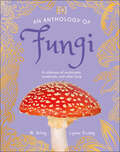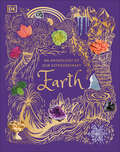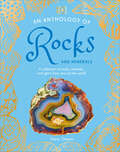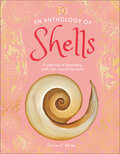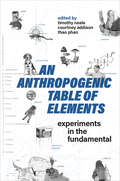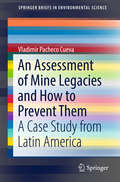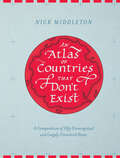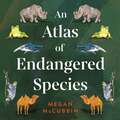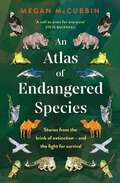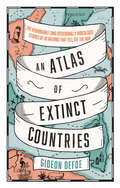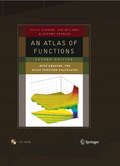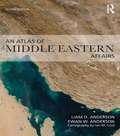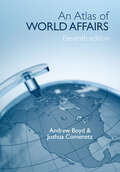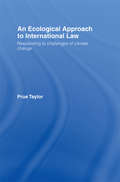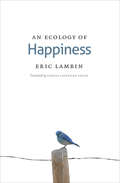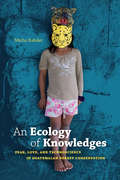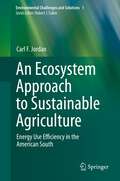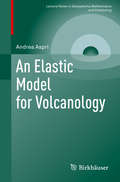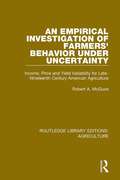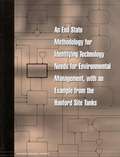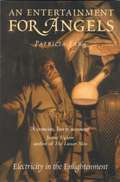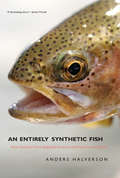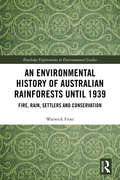- Table View
- List View
An Anthology of Fungi: A Collection of 100 Mushrooms, Toadstools and Other Fungi (DK Little Anthologies)
by Lynne Boddy Ali AshbyFind out how to identify, where to spot, and what to know about common woodland mushrooms and rare fungal finds with this beautiful field guide.Transportable in size and crammed with profiles of different mushrooms, An Anthology of Fungi covers toadstool species including fly agaric, porcelain fungus, velvet shank, wood blewit, and crimson waxcap, as well as lichens, brackets, and more.Featuring photographs of striking specimens and illustrations by the artist behind DK’s best-selling Anthology series, as well as plenty of intriguing information, this book will be one to treasure for young nature enthusiasts.
An Anthology of Our Extraordinary Earth (DK Children's Anthologies)
by Cally OldershawExplore the beauty and majesty of planet Earth in this compendium, with more than 100 incredible stories and images.The world is so much more complex than young minds can fathom, from molten-hot rock and smoldering volcanoes to icy glaciers and bubbling springs. This book about the Earth for kids aged 7+ unlocks all the mysteries of our living, breathing planet.An Anthology of Our Extraordinary Earth looks at our constantly changing planet, with striking images and scientific ideas that are easy for children to understand. Starting at the center of the Earth, the book examines each layer in forensic detail: from Earth&’s metallic core, drilling through Earth&’s tough crust until emerging out onto the planet&’s surface, with its lush green rainforests, sparkling oceans, and snow-capped mountains, before sailing up into Earth&’s airy atmosphere.This detailed planet Earth book for kids offers: - More than 100 stories about planet Earth, from snowflakes to cave pearls, each one accompanied by a photograph and delightful illustration.- Creative photography that presents planet Earth in surprising and remarkable ways, capturing nature in action or showing intriguing features up close.- Beautiful gold foil, gilded edges, and a ribbon for keeping your place.- In-depth feature pages that examine each layer of Earth.This striking book won&’t fail to excite budding geologists, geographers, environmentalists, and all-round planet Earth enthusiasts everywhere. With foil on the cover, gilded edges, and a ribbon for keeping your place, this Earth book makes an attractive gift for any child who is fascinated by our planet. With engaging information and absorbing images, this anthology is great for children to explore by themselves or for bedtime stories.More in the SeriesAn Anthology of Our Extraordinary Earth is part of DK&’s beautiful and informative Anthology series. Complete the series and nurture your child's curiosity as they explore the natural world with The Wonders of Nature, let them walk with the dinosaurs who ruled the Earth before them in Dinosaurs and other Prehistoric Life, or dive into the deep with An Anthology of Aquatic Life.
An Anthology of Rocks and Minerals: A Collection of 100 Rocks, Minerals, and Gems from Around the World (DK Little Anthologies)
by Devin DennieFind out how to identify, where to spot, and what to know about rocks, gems, and minerals with this beautiful field guide.Transportable in size and crammed with profiles of different specimens, An Anthology of Rocks and Minerals covers minerals that no collection would be complete without, including quartz, pyrite, moonstone, amethyst, lapis lazuli, and much more, as well as rock types that children will love spotting when they are out and about.Featuring photographs of striking specimens and illustrations by the artist behind DK’s best-selling Anthology series, as well as plenty of intriguing information, this book will be one to treasure for young rock and mineral enthusiasts.
An Anthology of Shells: A Collection of Fascinating Shells from Around the World (DK Little Anthologies)
by Simon AikenA beautiful collection featuring notes, spectacular photos, and illustrations of more than 100 types of shell.A compact version of DK’s bestselling anthology series, An Anthology of Shells is perfect for young nature enthusiasts aged 7-9 for taking on the go.Children can marvel at a wide range of shells from around the world that no collection would be complete without. Learn all about the shell shapes, colors, and textures–and get up close with the snails, crabs, and clams that live in them.This impressive shells anthology for kids offers:The third book in the new compact spin-off of the bestselling Children’s Anthologies series.A magnificent collection of over 100 shell profiles and their creatures from all over the world, from tropical rainforests to icy Antarctic waters.A quality gift book, with metallic foil and striking photographs on every page.An Anthology of Shells pairs photography with storybook descriptions that will captivate young readers, whether it’s marveling at conchs or clams. Featuring photographs of striking formations and illustrations by the artist behind DK’s bestselling Anthology series, as well as plenty of intriguing information, this book will be one to treasure for young conchologists.More in the seriesAnthology of Shells is part of the beautiful, new, and compact Anthology spin-off series. Complete the series and nurture your child's curiosity as they explore geology and earth materials with Rocks and Minerals or mushroom species with the Fungi field guide.
An Anthropogenic Table of Elements: Experiments in the Fundamental (Technoscience and Society)
by Timothy Neale Courtney Addison Thao PhanAn Anthropogenic Table of Elements provides a contemporary rethinking of Dmitri Mendeleev’s periodic table of elements, bringing together "elemental" stories to reflect on everyday life in the Anthropocene. Concise and engaging, this book provides stories of scale, toxicity, and temporality that extrapolate on ideas surrounding ethics, politics, and materiality that are fundamental to this contemporary moment. Examining elemental objects and forces, including carbon, mould, cheese, ice, and viruses, the contributors question what elemental forms are still waiting to emerge and what political possibilities of justice and environmental reparation they might usher into the world. Bringing together anthropologists, historians, and media studies scholars, this book tests a range of possible ways to tabulate and narrate the elemental as a way to bring into view fresh discussion on material constitutions and, thereby, new ethical stances, responsibilities, and power relations. In doing so, An Anthropogenic Table of Elements demonstrates through elementality that even the smallest and humblest stories are capable of powerful effects and vast journeys across time and space.
An Assessment of Mine Legacies and How to Prevent Them: A Case Study from Latin America (SpringerBriefs in Environmental Science)
by Vladimir Pacheco CuevaThis book seeks to enrich the growing literature on mine legacies by examining a case study of a small abandoned mine in Latin America. Using a combination of Rapid Rural Appraisal and secondary source analysis, this study assessed some of the most damaging legacies of the San Sebastian mine in eastern El Salvador, compared the country's mine closure legislation against world's best practice standards and provided strategies for awareness, prevention and remediation. The most damaging legacy to the environment is that of Acid Mine Drainage (AMD) contamination of the local river. The impact of AMD is felt well beyond the mining district and the costs of prevention and remediation were found to be significant. Apart from environmental legacies, the mine also left a number of socio-economic legacies including: limited access to non-polluted water that results in San Sebastian residents devoting a high proportion of their income in obtaining water, lost opportunities due to the cessation of mining, uncertain land tenure situation and increasing growth of ASGM activities that exacerbate already existing environmental pollution due to use of mercury. The study also found that the state's capacity to ensure compliance with the law is very weak and that in many important respects the country's current legal framework does not meet world's best practice when it comes to mine closure requirements. The findings are important because they demonstrate that the lack of closure planning can lead to private operators socializing the costs of pollution. The study also shows that the lack of state capacity may result in extractive projects becoming socio-economic liabilities in the long term.
An Atlas of Countries That Don't Exist: A Compendium of Fifty Unrecognized and Largely Unnoticed States
by Nick MiddletonA “fascinating” journey to little-known and contested lands around the globe, from Tibet to the Isle of Man to Elgaland-Vargaland (Geographical Magazine).What is a country? Acclaimed travel writer and Oxford geography don Nick Middleton brings to life the origins and histories of fifty states that, lacking international recognition and United Nations membership, exist on the margins of legitimacy in the global order. From long-contested lands like Crimea and Tibet to lesser-known territories such as Africa’s last colony and a European republic that enjoyed independence for a single day, Middleton presents fascinating stories of shifting borders, visionary leaders, and “forgotten” peoples. “Engrossing . . . You’ll not find Middle-earth, Atlantis or Lilliput inside, but you will find something just as intriguing . . . sure to prompt discussions about what makes a country a ‘real country.’” —Seattle Times
An Atlas of Endangered Species
by Megan McCubbinThree species vanish every hour. Our incredible world is at risk, and we all have a part to play in saving it.The diversity of life on earth is astounding, with each species perfectly adapted to its environment. Sharks can navigate the ocean using electromagnetic fields; sloths use algae as camouflage; albatross can fly for hours without beating their wings; and orca pods each have unique cultures and languages. But every hour, three species disappear. Our incredible world is at risk.Megan McCubbin reveals the stories of the scientists, rangers and conservationists who are fighting to save these extraordinary creatures from extinction. An Atlas of Endangered Species shows us that the battle is on for their survival - and we all have a part to play.'A call to arms for everyone' Steve Backshall'Joyful and heartbreaking, an inspiring celebration of some of our planet's most endangered species and those who champion them' - Dave Goulson, author of Silent Earth'A powerful, passionate plea for a wilder future' - Sophie Pavelle, author of Forget Me Not(P) 2023 Hodder & Stoughton Limited
An Atlas of Endangered Species
by Megan McCubbin'A call to arms for everyone' Steve BackshallThe diversity of life on earth is astounding, with each species perfectly adapted to its environment. Sharks can navigate the ocean using electromagnetic fields; sloths use algae as camouflage; albatross can fly for hours without beating their wings; and orca pods each have unique cultures and languages. But every hour, three species disappear. Our incredible world is at risk.Megan McCubbin reveals the stories of the scientists, rangers and conservationists who are fighting to save these extraordinary creatures from extinction. An Atlas of Endangered Species shows us that the battle is on for their survival - and we all have a part to play.'Joyful and heartbreaking, an inspiring celebration of some of our planet's most endangered species and those who champion them' - Dave Goulson, author of Silent Earth'A powerful, passionate plea for a wilder future' - Sophie Pavelle, author of Forget Me Not
An Atlas of Extinct Countries
by Gideon Defoe"Prisoners of Geography meets Bill Bryson: a funny, fascinating, beautifully illustrated—and timely—history of countries that, for myriad and often ludicrous reasons, no longer exist. “Countries are just daft stories we tell each other. They’re all equally implausible once you get up close.” Countries die. Sometimes it’s murder, sometimes it’s by accident, and sometimes it’s because they were so ludicrous they didn’t deserve to exist in the first place. Occasionally they explode violently. A few slip away almost unnoticed. Often the cause of death is either “got too greedy” or “Napoleon turned up.” Now and then they just hold a referendum and vote themselves out of existence. This is an atlas of 48 nations that fell off the map. The polite way of writing an obituary is: dwell on the good bits, gloss over the embarrassing stuff. This book refuses to do so, because these dead nations are so full of schemers, racists, and con men that it’s impossible to skip the embarrassing stuff. Because of this – and because treating nation-states with too much reverence is the entire problem with pretty much everything – these accounts are not concerned with adding to the earnest flag saluting in the world, however nice some of the flags might be."
An Atlas of Functions: with Equator, the Atlas Function Calculator
by Keith B. Oldham Jerome Spanier Jan MylandThis second edition of An Atlas of Functions, with Equator, the Atlas Function Calculator, provides comprehensive information on several hundred functions or function families, of interest to all those scientists, engineers and mathematicians who are concerned with the quantitative aspects of their field. Beginning with simple integer-valued functions, the book progresses to polynomials, exponential, trigonometric, Bessel, and hypergeometric functions, as well as many more. The 65 chapters are arranged roughly in order of increasing complexity, mathematical sophistication being kept to a minimum while utility is stressed throughout. In addition to providing definitions and simple properties for every function, each chapter catalogs more complex interrelationships as well as the derivatives, integrals, Laplace transforms and other characteristics of the function. Numerous color figures in 2 or 3 dimensions depict their shape and qualitative features and flesh out the reader's familiarity with the functions. In many instances, the chapter concludes with a concise exposition on a topic in applied mathematics associated with the particular function or function family. Features that make the Atlas an invaluable reference tool, yet simple to use, include: full coverage of those functions--elementary and "special"--that meet everyday needsa standardized chapter format, making it easy to locate needed information on such aspects as: nomenclature, general behavior, definitions, intrarelationships, expansions, approximations, limits, and response to operations of the calculusextensive cross-referencing and comprehensive indexing, with useful appendicesthe inclusion of innovative software--Equator, the Atlas Function Calculatorthe inclusion of new material dealing with interesting applications of many of the function families, building upon the favorable responses to similar material in the first edition.
An Atlas of Middle Eastern Affairs
by Ewan W. Anderson Liam D. AndersonThis revised and updated version of An Atlas of Middle Eastern Affairs provides accessible, concisely written entries on the most important current issues in the Middle East, combining maps with their geopolitical background. Offering a clear context for analysis of key concerns, it includes background topics, the position of the Middle East in the world and profiles of the constituent countries. Features include: Clearly and thematically organised sections covering the continuing importance of the Middle East, the background, fundamental concerns, the states and the crucial issues related to the area. Original maps integrated into the text, placing international issues and conflicts in their geographical contexts. Case studies and detailed analysis of each country, complete with relevant statistics and key facts. Coverage of fundamental considerations, such as: water shortage the petroleum industry conflicts and boundary issues A comprehensive further reading section, enabling students to cover the topic in more depth. Updated to include recent developments such as the "Arab Spring," this book is a valuable introduction to undergraduate students of political science and Middle East studies and is designed as a primary teaching aid for courses related to the Middle East in the areas of politics, history, geography, economics and military studies. This book is also an outstanding reference source for libraries and anyone interested in these fields.
An Atlas of World Affairs
by Joshua Comenetz Andrew BoydThe economic, social and environmental systems of the world remain in turmoil. Recent years have seen possibly irrevocable change in the politics of Europe, Asia, Africa and Latin America. This entirely revised and updated 11th edition describes the people, factions, and events that have shaped the modern world from the Second World War to the present day. International issues and conflicts are placed in their geographical contexts through the integration of over one hundred maps. The political context provided for current events will be invaluable to all those uncertain about the changing map of Europe and Africa, conflicts in the Middle East, and the appearances in the headlines and on our television screens by al-Qaeda, Chechnya, the Taliban, Mercosur, Somaliland, Kosovo, AIDS, OPEC, and Schengenland. Critical new issues are covered including the war on terrorism, nuclear proliferation, European Union expansion, and the pressing environmental concerns faced by many sovereign states. This edition provides guidance through all these recent changes (and many more). This book offers up-to-date coverage of all regions in great detail. It contains an objective and concise explanation of current events, combining maps with their geopolitical background. It provides a clear context for events in the news, covering the Middle East, Korea, China, the European Union, east Africa, and every other part of the world. Revised and in print since 1957, An Atlas of World Affairs continues to provide a valuable guide for the student, teacher, journalist and all those interested in current affairs and post-war political history.
An Ecological Approach to International Law: Responding to the Challenges of Climate Change
by Prue TaylorAn Ecological Approach to International Law shows that international environmental law is fundamentally flawed and not equipped to meet global challenges. The book examines international legal responses to global climate change by analysing key concepts such as the doctrine of state sovereignty, the law on state responsibility, environmental rights and common heritage of mankind.
An Ecology of Happiness
by Eric LambinThe scientific evidence that a healthy planet equals happier humans: &“Highly recommended.&”—Library Journal We&’ve heard plenty about the big-picture damage and danger of environmental degradation. But there hasn&’t been much focus on its impact on us and our well-being. You sense it while walking on a sandy beach or in a forest, or when you catch sight of wildlife, or even while gardening in your backyard. Could it be that the natural environment is an essential part of our happiness? In this wide-ranging work, Eric Lambin draws on new scientific evidence in the fields of geography, political ecology, environmental psychology, urban studies, and disease ecology, among others, to answer such questions as: To what extent do we need nature for our well-being? What can be done to protect the environment and increase our well-being at the same time? Drawing on case studies from Asia, Africa, Europe, and North America, Lambin makes a persuasive case for the strong link between healthy ecosystems and happy humans. An Ecology of Happiness offers a compelling, powerful argument to help motivate commitment and action: Whether it&’s brilliant fall foliage or birdsong, nature makes our steps a little lighter and our eyes a little brighter. What better reason to protect an ecosystem or save a species than for our own pleasure? &“Anyone who has ever delighted in the earthy scent of a springtime stroll in the woods, a walk on the beach, or a starry gaze into the universe now has scholarly proof. Nature, not money or material possessions, makes us happy.&”—Ruth DeFries, Columbia University, author of The Big Ratchet
An Ecology of Knowledges: Fear, Love, and Technoscience in Guatemalan Forest Conservation (Experimental Futures)
by Micha RahderGuatemala's Maya Biosphere Reserve (MBR), the largest protected area in Central America, is characterized by rampant violence, social and ethnic inequality, and rapid deforestation. Faced with these threats, local residents, conservationists, scientists, and NGOs in the region work within what Micha Rahder calls “an ecology of knowledges,” in which interventions on the MBR landscape are tied to differing and sometimes competing forms of knowing. In this book, Rahder examines how technoscience, endemic violence, and an embodied love of wild species and places shape conservation practices in Guatemala. Rahder highlights how different forms of environmental knowledge emerge from encounters and relations between humans and nonhumans, institutions and local actors, and how situated ways of knowing impact conservation practices and natural places, often in unexpected and unintended ways. In so doing, she opens up new ways of thinking about the complexities of environmental knowledge and conservation in the context of instability, inequality, and violence around the world.
An Ecosystem Approach to Sustainable Agriculture: Energy Use Efficiency in the American South (Environmental Challenges and Solutions #1)
by Carl F. JordanModern industrial agriculture is not sustainable because of its heavy reliance on petroleum, a non-renewable source of the energy used in farming, and because of pollution caused by petroleum products such as fertilizers and pesticides. A systems analysis of farming suggests that agriculture will be more sustainable when services of nature, such as nutrient recycling by soil micro-organisms and natural controls of insects, replace the services now provided by energy from petroleum. Examples are drawn from the Southeastern USA, but lessons learned can be applied worldwide.
An Elastic Model for Volcanology (Lecture Notes in Geosystems Mathematics and Computing)
by Andrea AspriThis monograph presents a rigorous mathematical framework for a linear elastic model arising from volcanology that explains deformation effects generated by inflating or deflating magma chambers in the Earth’s interior. From a mathematical perspective, these modeling assumptions manifest as a boundary value problem that has long been known by researchers in volcanology, but has not, until now, been given a thorough mathematical treatment. This mathematical study gives an explicit formula for the solution of the boundary value problem which generalizes the few well-known, explicit solutions found in geophysics literature. Using two distinct analytical approaches—one involving weighted Sobolev spaces, and the other using single and double layer potentials—the well-posedness of the elastic model is proven. An Elastic Model for Volcanology will be of particular interest to mathematicians researching inverse problems, as well as geophysicists studying volcanology.
An Empirical Investigation of Farmers Behavior Under Uncertainty: Income, Price and Yield Variability for Late-Nineteenth Century American Agriculture (Routledge Library Editions: Agriculture #12)
by Robert A. McGuireThis study, first published in 1985, aims to provide objective measures of the risks associated with various crops and livestock in the late nineteenth century and to examine two important issues in American economic history. Knowledge of these risks if a necessity to the profession, if analyses of the uncertainties of postbellum agriculture are to continue. Without this knowledge, assertions which have little or no empirical content will continue to be made. This title will be of great interest to students of economics and agriculture.
An End State Methodology for Identifying Technology Needs for Environmental Management, with an Example from the Hanford Site Tanks
by Committee on Technologies for Cleanup of High-Level Waste in Tanks in the DOE Weapons ComplexThe National Academies Press (NAP)--publisher for the National Academies--publishes more than 200 books a year offering the most authoritative views, definitive information, and groundbreaking recommendations on a wide range of topics in science, engineering, and health. Our books are unique in that they are authored by the nation's leading experts in every scientific field.
An Entertainment for Angels: Electricity in the Enlightenment
by Patricia FaraCharacterizing electricity as "the greatest scientific invention of the Enlightenment," Fara (history of science, U. of Cambridge, UK) reconstructs the history of the discovery of electricity that pre- existed Benjamin Franklin's oft-cited kite. It is a history in which the instruments largely preceded the theory and "there was no clear path of development." Nevertheless, the development of those instruments, especially air pumps and Leyden jars, was absolutely necessary for later discoveries about electricity. Annotation ©2004 Book News, Inc., Portland, OR (booknews.com)
An Entirely Synthetic Fish
by Anders HalversonAnders Halverson provides an exhaustively researched and grippingly rendered account of the rainbow trout and why it has become the most commonly stocked and controversial freshwater fish in the United States. Discovered in the remote waters of northern California, rainbow trout have been artificially propagated and distributed for more than 130 years by government officials eager to present Americans with an opportunity to get back to nature by going fishing. Proudly dubbed "an entirely synthetic fish" by fisheries managers, the rainbow trout has been introduced into every state and province in the United States and Canada and to every continent except Antarctica, often with devastating effects on the native fauna. Halverson examines the paradoxes and reveals a range of characters, from nineteenth-century boosters who believed rainbows could be the saviors of democracy to twenty-first-century biologists who now seek to eradicate them from waters around the globe. Ultimately, the story of the rainbow trout is the story of our relationship with the natural world--how it has changed and how it startlingly has not.
An Environmental History of Australian Rainforests until 1939: Fire, Rain, Settlers and Conservation (Routledge Explorations in Environmental Studies)
by Warwick FrostThis book provides a comprehensive environmental history of how Australia’s rainforests developed, the influence of Aborigines and pioneers, farmers and loggers, and of efforts to protect rainforests, to help us better understand current issues and debates surrounding their conservation and use. While interest in rainforests and the movement for their conservation are often mistakenly portrayed as features of the last few decades, the debate over human usage of rainforests stretches well back into the nineteenth century. In the modern world, rainforests are generally considered the most attractive of the ecosystems, being seen as lush, vibrant, immense, mysterious, spiritual and romantic. Rainforests hold a special place; both providing a direct link to Gondwanaland and the dinosaurs and today being the home of endangered species and highly rich in biodiversity. They are also a critical part of Australia’s heritage. Indeed, large areas of Australian rainforests are now covered by World Heritage Listing. However, they also represent a dissonant heritage. What exactly constitutes rainforest, how it should be managed and used, and how much should be protected are all issues which remain hotly contested. Debates around rainforests are particularly dominated by the contradiction of competing views and uses – seeing rainforests either as untapped resources for agriculture and forestry versus valuing and preserving them as attractive and sublime natural wonders. Australia fits into this global story as a prime example but is also of interest for its aspects that are exceptional, including the intensity of clearing at certain periods and for its place in the early development of national parks. This book will be of great interest to students and scholars of Environmental History, Australian History and Comparative History.
An Environmental History of Latin America
by Shawn William MillerThis book narrates the mutually mortal historical contest between humans and nature in Latin America. Covering a period that begins with Amerindian civilizations and concludes in the region's present urban agglomerations, the work offers an original synthesis of the current scholarship on Latin America's environmental history and argues that tropical nature played a central role in shaping the region's historical development. Seeing Latin America's environmental past from the perspective of many centuries illustrates that human civilizations, ancient and modern, have been simultaneously more powerful and more vulnerable than previously thought.
An Environmental History of Russia
by Paul Josephson Nicolai Dronin Aleh Cherp Ruben Mnatsakanian Dmitry Efremenko Vladislav LarinThe former Soviet empire spanned eleven time zones and contained half the world's forests; vast deposits of oil, gas and coal; various ores; major rivers such as the Volga, Don and Angara; and extensive biodiversity. These resources and animals, as well as the people who lived in the former Soviet Union – Slavs, Armenians, Georgians, Azeris, Kazakhs and Tajiks, indigenous Nenets and Chukchi – were threatened by environmental degradation and extensive pollution. This environmental history of the former Soviet Union explores the impact that state economic development programs had on the environment. The authors consider the impact of Bolshevik ideology on the establishment of an extensive system of nature preserves, the effect of Stalinist practices of industrialization and collectivization on nature, and the rise of public involvement under Khrushchev and Brezhnev, and changes to policies and practices with the rise of Gorbachev and the break-up of the USSR.
